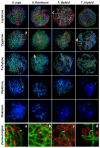The Control of the Crossover Localization in Allium
- PMID: 37108228
- PMCID: PMC10138942
- DOI: 10.3390/ijms24087066
The Control of the Crossover Localization in Allium
Abstract
Meiotic crossovers/chiasmata are not randomly distributed and strictly controlled. The mechanisms behind crossover (CO) patterning remain largely unknown. In Allium cepa, as in the vast majority of plants and animals, COs predominantly occur in the distal 2/3 of the chromosome arm, while in Allium fistulosum they are strictly localized in the proximal region. We investigated the factors that may contribute to the pattern of COs in A. cepa, A. fistulosum and their F1 diploid (2n = 2x = 8C + 8F) and F1 triploid (2n = 3x = 16F + 8C) hybrids. The genome structure of F1 hybrids was confirmed using genomic in situ hybridization (GISH). The analysis of bivalents in the pollen mother cells (PMCs) of the F1 triploid hybrid showed a significant shift in the localization of COs to the distal and interstitial regions. In F1 diploid hybrid, the COs localization was predominantly the same as that of the A. cepa parent. We found no differences in the assembly and disassembly of ASY1 and ZYP1 in PMCs between A. cepa and A. fistulosum, while F1 diploid hybrid showed a delay in chromosome pairing and a partial absence of synapsis in paired chromosomes. Immunolabeling of MLH1 (class I COs) and MUS81 (class II COs) proteins showed a significant difference in the class I/II CO ratio between A. fistulosum (50%:50%) and A. cepa (73%:27%). The MLH1:MUS81 ratio at the homeologous synapsis of F1 diploid hybrid (70%:30%) was the most similar to that of the A. cepa parent. F1 triploid hybrid at the A. fistulosum homologous synapsis showed a significant increase in MLH1:MUS81 ratio (60%:40%) compared to the A. fistulosum parent. The results suggest possible genetic control of CO localization. Other factors affecting the distribution of COs are discussed.
Keywords: ASY1; Allium; GISH; MLH1; MUS81; ZYP1; chiasmata localization.
Conflict of interest statement
The authors declare no conflict of interest.
Figures





Similar articles
-
[Chromosomal structure of the hybrids between Allium cepa L. and Allium fistulosum L. with relative resistance to downy mildew based on in situ hybridization].Genetika. 2014 Apr;50(4):443-51. Genetika. 2014. PMID: 25715446 Russian.
-
Comparative analysis of crossover exchanges and chiasmata in Allium cepa x fistulosum after genomic in situ hybridization (GISH).Chromosome Res. 1998 Nov;6(7):567-74. doi: 10.1023/a:1009296826942. Chromosome Res. 1998. PMID: 9886776
-
Cytological Evaluations of Advanced Generations of Interspecific Hybrids Between Allium cepa and Allium fistulosum Showing Resistance to Stemphylium vesicarium.Genes (Basel). 2019 Mar 4;10(3):195. doi: 10.3390/genes10030195. Genes (Basel). 2019. PMID: 30836702 Free PMC article.
-
Allodiploid nature of Allium wakegi Araki revealed by genomic in situ hybridization and localization of 5S and 18S rDNAs.Jpn J Genet. 1994 Aug;69(4):407-15. doi: 10.1266/jjg.69.407. Jpn J Genet. 1994. PMID: 7946461
-
Production and characterization of alien chromosome additions in shallot (Allium cepa L. Aggregatum group) carrying extra chromosome(s) of Japanese bunching onion (A. fistulosum L.).Genes Genet Syst. 2004 Oct;79(5):263-9. doi: 10.1266/ggs.79.263. Genes Genet Syst. 2004. PMID: 15599056
Cited by
-
A Method of Well-Spread Pachytene Chromosome Preparations for Plant Species with Large Genomes Suitable for the Immunolocalization of Meiotic Proteins.Methods Protoc. 2025 May 19;8(3):54. doi: 10.3390/mps8030054. Methods Protoc. 2025. PMID: 40407481 Free PMC article.
References
-
- Darlington C. Meiosis in diploid and tetraploid Primula sinensis. J. Genet. 1931;24:65–96. doi: 10.1007/BF03020823. - DOI
MeSH terms
Grants and funding
LinkOut - more resources
Full Text Sources

